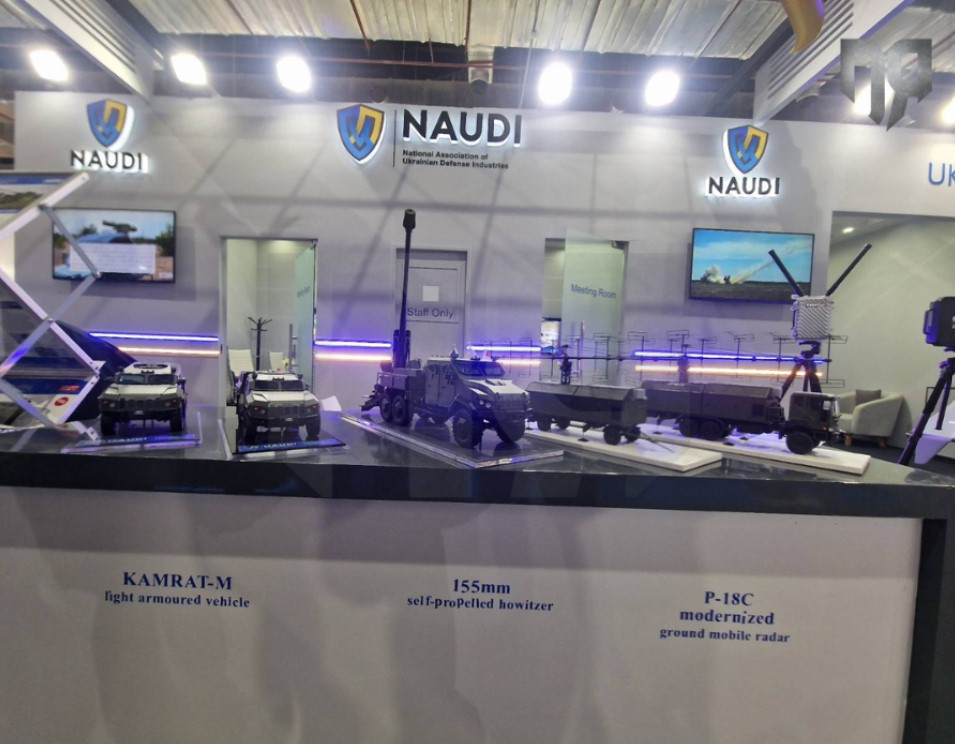Poland receives its first two 5th generation F-35 Lightning II aircraft from the US Lockheed Martin. The Polish Air Force’s first…

Following our previous article on the unmanned and anti-drone systems of the Ukrainian defence industry showcased at EDEX 2023, this article focuses on missile systems, vehicles, and anti-tank solutions from war-torn Ukraine.
‘LUCH’ STATE KYIV DESIGN BUREAU
LUCH State Kyiv Design Bureau is one of the manufacturers of parts for aircraft and anti-tank systems in Ukraine. Owing to the company’s scientific and technical potential and production capacities, a wide range of military products and services are provided.
Skif-M ATGM

The Skif system, known as the Stugna-P in Ukrainian service, has been widely used by the Ukrainian Armed Forces since 2018, and has been exported to eight countries. Since 2022, a new upgraded version, the Skif-M, has been manufactured.
Improvements brought to the Skif-M include, among others, a lighter-weight tripod and the new PN-U sighting and guidance unit (SGU).
The SGU includes a laser rangefinder, which was incorporated upon the Ukrainian forces’ request. Experience from combat in Ukraine demonstrated that the risk of the laser unit being detected was low, as Russian forces did not seem to equip many of their vehicles with laser-warning receivers.
In 2022, following the Russian invasion, some of the Skif launchers, originally produced for export customers from the Middle East, were delivered to the Ukrainian Armed Forces instead. These anti-tank missiles have destroyed numerous Russian tanks, armored vehicles, and in certain cases, attack helicopters.
The Skif is distinctive for its simplicity in design. Both the missile launch tube and fire control system are mounted on a launcher unit stabilized by a small extendable tripod. The Skif’s fire control system is a box-like 15-kilogram TV channel guidance unit married to an SLX-Hawk thermal imaging camera. Further, the Skif features a separate control panel in a case.
The Skif’s PDU-215 control panel is a laptop married to a control panel, including a small joystick and a flat-screen display to assist the missile’s guidance. Skif operators have the advantage of two firing modes for engaging targets, which serve as manual guidance when used in concealment, and a fire-and-forget option for ambushes.
A typical three-member team is required for deploying this man-portable system. The operator carries the remote control and another soldier the guidance device, while both are also holding either part of the launcher unit. The third soldier is responsible for the missile supply.
Skif technical characteristics:
- Range: 5 km
- Missile length: 1,091 mm
- Missile diameter: 130 mm RK-2S (tandem HEAT) / 152 mm RK-2M-K (tandem HEAT)
- Missile weight (in container): 29.5 / 38 kg
- Warhead weight: 8 kg
- Launcher weight: 32 kg
- Sight weight:15 kg
- Control panel weight: 8-10 kg
- Warhead type: Tandem HEAT
- Guidance: Laser-guided
- Target acquisition: EO sensor
RK-3 CORSAR

LUCH State Kyiv Design Bureau also showcased the Corsar missile system.
According to the company, the lightweight anti-tank missile system can destroy stationary and moving modern armored targets as well as weapon depots, platforms, light-armored objects, and helicopters via a laser guidance system.
Corsar technical characteristics:
- Maximum range: 2500 meters
- Flight time: 12 sec
- Warhead type: thermobaric / high-explosive fragmentation/tandem hollow-charge
- Total weight: 35.8 kg
- Launcher with thermal imager: 12 kg
- Mount: 8.3 kg
- Missile in container: 15.5 kg
- Missile length: 1.16 meters
- Missile diameter: 107 m
- Operational temperature: -40 to +60 оС
Also read: Javelin | The anti-tank missile that has become a symbol of the Ukrainian resistance
Neptune 360ST Missile System

LUCH also exhibited a coastal version of the renowned Neptune anti-ship cruise missile (destroyer of the Black Sea flagship ‘Moskva’). The new Neptune 360 ST missile system configuration includes a USPU-360 portable launcher with four canisters for the R-360 guided missile with a 300-km range and a warhead weighing 150 kg.

Also read: Ukraine | Havoc caused by Russian fleet flagship “Moskva” – All information
Vilkha MLRS

What truly attracted the audience to Ukraine’s pavilion was the locally-made Vilkha, a Multiple Launch Rocket System (MLRS) which conducted its first firing test in 2018.
The Ukrainian Vilkha is based on the Soviet-made BM-30 Smerch 300 mm MLRS using the same 8×8 MZKT MAZ-543 truck chassis and launcher station. The 300 mm rocket tube arrangement consists of two separate banks of four with a connecting roof of the remaining four tubes overlying the inner tubes of the banks.

The Vilkha is operated by a crew of four. The driver’s cab is located on the front left side of the truck with the launch cabin positioned behind the driver’s cab. According to the company, the rocket used by the Vilkha can reach a range of up to 110 km compared to HIMARS’ 300 km range. It can fire 12 missiles in 45 seconds and engage targets with a circular error probability (CEP) of less than 30 m.
The Vilkha is equipped with a new automated fire-control system which can be operated in either auto or manual modes.
Also read: HIMARS | Multiple launchers sent by the US to Ukraine – VIDEO

UKRAINIAN ARMOR LLC
Ukrainian Armor produces the VARTA, NOVATOR, and KAMRAT armored vehicles in different configurations and for different purposes, such as surveillance and reconnaissance, border patrolling, special missions, personnel carrier, and medical evacuation.
At EDEX 2023, the company presented a mock-up of the Kamrat-M light armored vehicle for versatile operations. One of the key features of the system is its adaptability to various conditions such as desert heat or the icy terrains of the Arctic.
Whether it’s a five-person pick-up version or a ten-person personnel carrier, the Kamrat-M provides a high level of protection against bullets, shrapnel, and light explosions. The combat version of the vehicle can be equipped with a wide range of weapon stations and armaments, while both ballistic and anti-mine protection is applied, in accordance with STANAG 4569 Level 1 and Level 2a standards.
Its technical characteristics include:
- Range: 500 – 700 km
- Weight: 8,845 kg (to an optional 12,000 kg)
- Payload capacity: 2,000 kg
- Length (depending on the version): between 6,500 and 7,000 mm
- Width: 2,450 mm
- Height: 2,385 mm
- Ground clearance: 300 mm
- Maximum speed: 140 km/h
- Engine: 330 hp
- Gradient: 30°
- Side slope: 20°
- Fording depth: 0.75 m
2S22 Bohdana
The 2S22 Bohdana artillery system, also showcased at EDEX 2023, is a 155 mm NATO-standard, wheeled, self-propelled howitzer developed in Ukraine.
It is mounted on the chassis of the Ukrainian six-wheel-drive KrAZ-6322 truck. It has an armored double cabin and storage for around 20 shells. The howitzer has a maximum range of 50 km (depending on the projectile) and a firing rate of six rounds per minute. It weighs 28 tons, hosts a crew of 5, and has an engine of 420 hp, which provides an operational range of 1,200 km.
P-18C GROUND MOBILE RADAR
The ground-based mobile radar station P-18C was also presented at the said exhibition. This radar system operates in the VHF band and it is designed to automatically detect targets, determine current coordinates (azimuth and range), and automatically send radar data (RD) to users.
According to the manufacturers, the scope of the specific functions performed, as well as the composition of individual software and hardware, may vary depending on the configuration and the radar design.
Also read: Ukraine | The Netherlands to deliver VERA-NG passive radars of Czech ERA
Vladyslav Belbas, Director-General of NAUDI, mentioned that Ukraine seeks to localize its defence industry, while at the same time, is in search of finding new partners for joint productions and developments, supply of components, and consumption of artillery to extend production capacities under current wartime circumstances.
READ MORE
MAESTRO | IANUS Technologies’ Crisis Management Platform at BATTLEFIELD REDEFiNED 2024
IANUS Technologies Ltd., a Cypriot company specialising in security, cybersecurity, and defence solutions, presented a very interesting…
Ground Warden Vehicle | MBDA’s cutting-edge solution with missiles, loitering munitions and drones – Video & Photos
During the EUROSATORY 2024 Defence and Security exhibition, MBDA presented the Ground Warden Vehicle solution, an innovative…
Poland | Receives First F-35 Lightning II Aircraft
Poland receives its first two 5th generation F-35 Lightning II aircraft from the US Lockheed Martin. The Polish Air Force’s first…
MAESTRO | IANUS Technologies’ Crisis Management Platform at BATTLEFIELD REDEFiNED 2024
IANUS Technologies Ltd., a Cypriot company specialising in security, cybersecurity, and defence solutions, presented a very interesting…
USA | Biden Administration Announces $8 Billion Arms Sale to Israel
Joe Biden’s administration announced an $8 billion arms sale to Israel shortly before Donald Trump’s inauguration.
One-day Event for the Eastern Mediterranean and Cyprus at Neapolis Paphos University
On Wednesday, January 15, 2025, from 18:00 to 19:30, an important one-day event will be held at the “Kerynia” Amphitheatre…
Ivory Coast | Withdrawal of French Military Forces from the country
The President of the Ivory Coast, Alassane Ouattara, announced recently that French forces will withdraw from the West African country…
Ground Warden Vehicle | MBDA’s cutting-edge solution with missiles, loitering munitions and drones – Video & Photos
During the EUROSATORY 2024 Defence and Security exhibition, MBDA presented the Ground Warden Vehicle solution, an innovative…



















